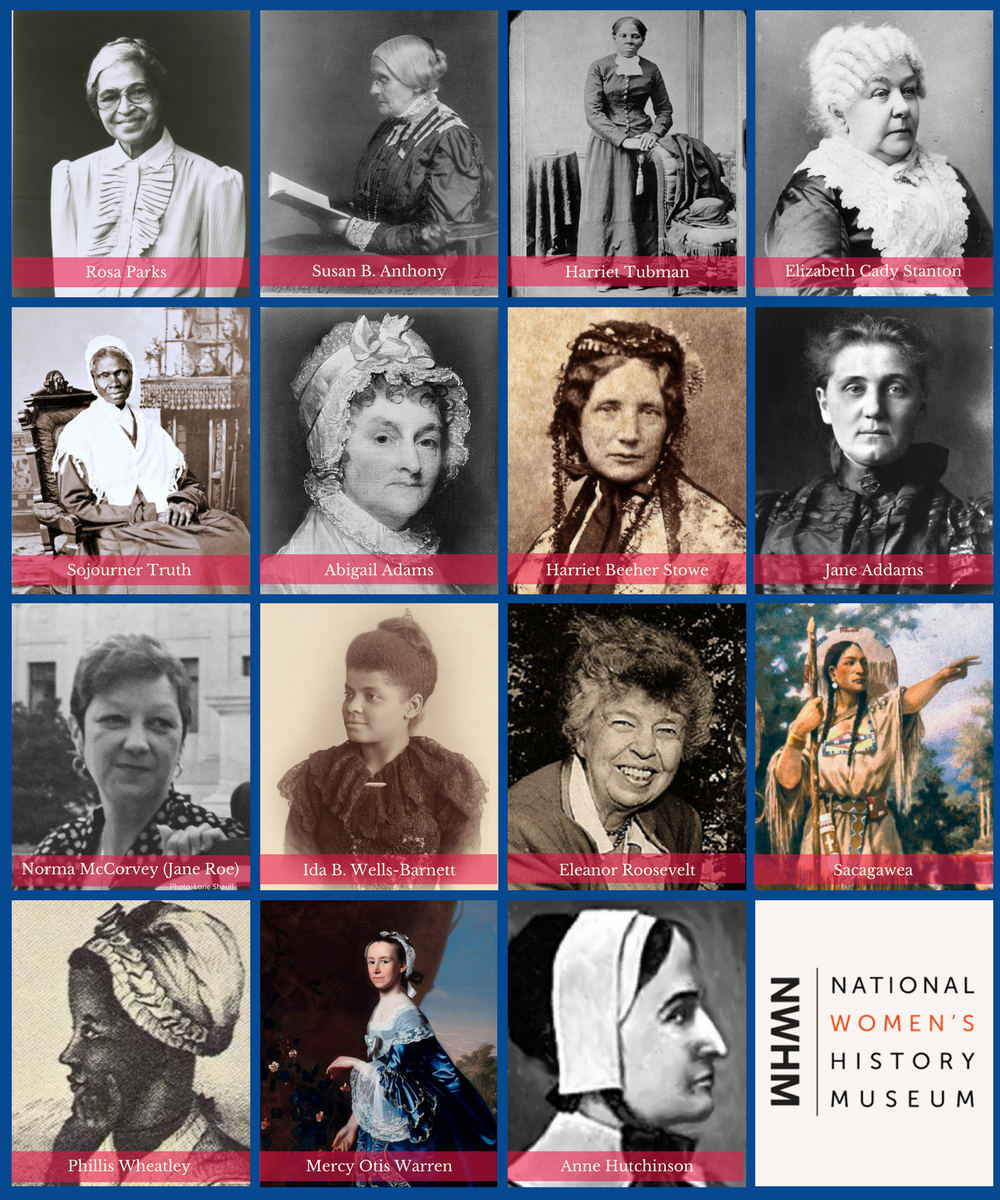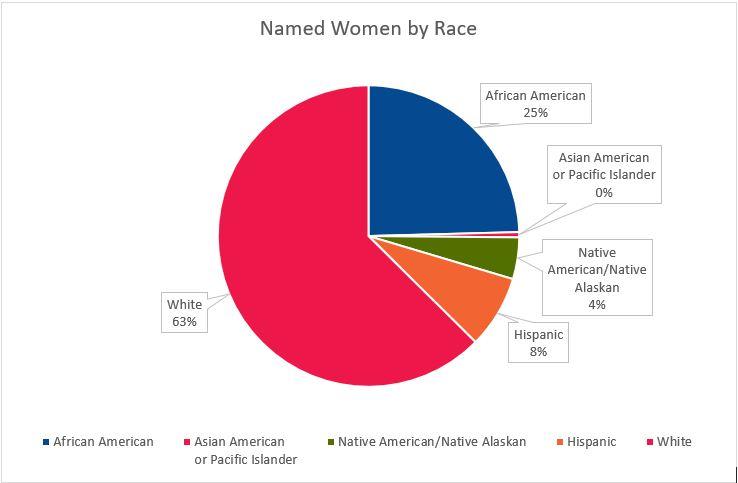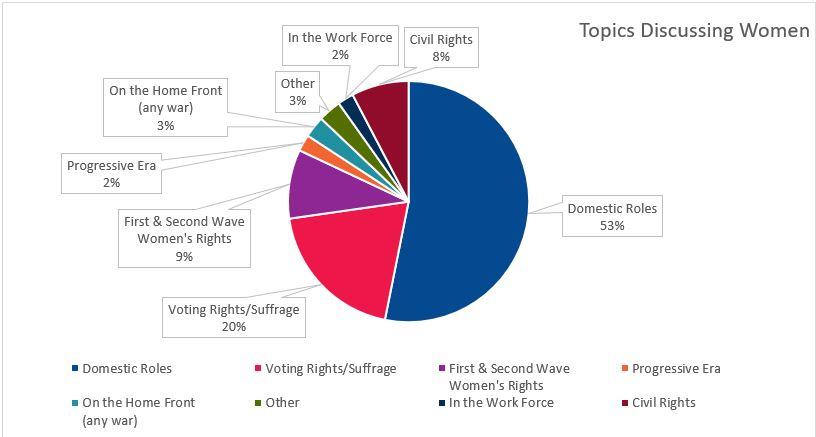Where are the Women?

Where are the Women? examines the status of women's history in state level social studies standards. States have devised sets of learning standards that describe what students are expected to know and be able to do at specific stages of education. The report and analysis finds that women's experiences and stories are not well integrated into US state history standards. The lack of representation and context in state-level materials presupposes that women's history is even less represented at the classroom level. This implies that women's history is not important.
Project Methodology
NWHM scholars read the social studies standards for each state and the District of Columbia. Project staff highlighted every standard that referred to a woman or a topic associated with women. Each standard was copied into a database. Researchers—following guidance from the Museum’s advisory council of scholars, public historians, and educators—reviewed the database entries to ensure that the selected standards met the project’s definitions of history about women. In the final step, researchers counted the number of times that women’s names and key terms occurred within the standards. The analysis describes the way that women’s history is characterized in US K-12 social studies standards. It suggests that women are excluded because the standards’ historiographical framework preferences male-oriented exceptional leadership while over-emphasizing women’s domestic roles.
Interesting Findings
Individual Women
One hundred seventy-eight individual women are named in state standards. Fifteen women are named more than ten times in standards. Individual women listed in standards are usually those who achieved a level of national or regional name recognition for their activities.

Women by Race
Since the new history movement that began in the 1960s, coinciding with modern rights movements, many states include the history of marginalized groups in standards. Women as a group are often characterized as one of these marginalized groups along with ethnic minority groups and the working class. Non-elite, non-white women who appear in the standards are most often associated with the history of their marginalized groups. The 178 women listed in standards occupy the following racial distribution.

The distribution of women by racial category reflects the emphasis on standards on protest movements. The first women’s rights movement in the nineteenth century arose as elite, white women challenged social, economic, political, and cultural definitions of women’s roles. Many of these women rose to national prominence by effective use of the media. Elite, white women who had the most access to resources to advance their causes are over represented in the standards. African American women are most often connected to the Abolitionist and modern Civil Rights movements, which are widely included in standards. Other rights movements like disability rights, Native American rights, LGBTQ, or migrant labor movements are less frequently included in standards and, when they are, in less detail. Therefore, they have fewer corresponding biographical entries.
Topics About Women
State standards divide social studies into topic areas. While women occasionally appear by name under topics, more often women are listed as a group. In some cases, topics are understood to be about women or inclusive of women—i.e. Seneca Falls Convention, family, or the home front. With the guidance of the Museum’s Advisory Council, NWHM scholars culled a list of terms from the data that assumes standards writers intended the standards to be inclusive of women’s roles and activities. NWHM scholars found 1,975 mentions of women, women’s history, and women’s roles within all state standards.
The standards overwhelmingly emphasize women in their domestic roles.

NWHM scholars did not count the total number of standards, men by name, or the number of topics about men. Therefore, the project cannot determine the percentage of women’s topics relative to all topics within all state standards.
What We Learned
- Standards prioritize listing women of accomplishment, which reflects the standards’ overall tendency to celebrate individual leadership and achievement.
- State standards do not collectively address the breadth and depth of women’s history. Rather, standards address a minority of topics and groups.
- Standards over emphasize women in their domestic roles without placing women’s activities in broader economic, cultural, or political contexts.
- A small number of topics or eras that are commonly associated with being women-centric are emphasized, such as the Progressive Era and Woman Suffrage/Voting Rights.
- The presentation of women within standards does not reflect current scholarship.
- Standards do not reflect current trends or ideals in girls’ education. While there is an increasing public interest in motivating girls to embrace science, technology, engineering, and mathematics, social studies standards provide few historic examples of women or their achievements in these fields.
The Takeaway
This result of this project is a data set of women and topics within US history standards. The state standards are not women’s history as understood by academic historians. Women’s history studies historical events, topics, people, and subjects from a woman’s perspective. It understands that culture affects experience and that women’s historical experiences differed from men’s. Women’s history contextualizes women within the social, political, legal, and cultural systems of their times. History that does not acknowledge women’s situations as well as their activities and accomplishments is, by definition, not a full history. We found that women’s topics are often an addendum to the main storyline. Women are frequently included in lists of marginalized groups as a reminder to teachers that when covering a broad topic, they should also include the experiences of women among others.
Now that NWHM scholars have identified the common women’s topics in history standards, the National Women's History Museum will embark on the next phase of our curriculum project. Throughout the next year, NWHM scholars and staff will work with master educators, scholars, and public history experts to create a wealth of materials to support teachers and students. Our emphasis will be on the topics in national standards to ensure that teachers have high quality materials in specified topic areas. And NWHM scholars will further create materials that integrate women's historical experiences across the curriculum. Educators and parents will be able to examine any historical topic from a woman's perspective while meeting standards' learning objectives.
Call to Action
The current standards represent an opportunity for thoughtful dialog around women’s history in K-12 public education. An opportunity exists for researchers to make more in-depth explorations of how women’s history is presented in the US state standards. NWHM scholars hope that this report will inspire teachers, scholars, students, and parents to examine the ways in which women’s historical experiences are presented in classrooms. We encourage all our stakeholders to advocate for the inclusion of women’s history in standards, and therefore curriculum, now and into the future.
Click the link below to download the Full Report and Data Set, including a listing of each state's learning standards related to women below.
Unladylike2020 Where Are the Women? Virtual Education Summit
To address why women are vastly underrepresented in U.S. history and social studies classrooms, and provide teachers and parents access to the educational support they need to reverse this trend, UNLADYLIKE2020 convened the 2-hour Where Are the Women? Summit on Saturday February 13, 2021, streaming live on the American Masters YouTube channel.
The Where Are the Women? Summit was presented by Unladylike2020 in partnership with PBS’s flagship biography series American Masters, WNET, National Women’s History Museum, National Council for the Social Studies, National Council for History Education, National Women’s Hall of Fame, and National Women’s History Alliance, with educational content provided by PBS LearningMedia and funding from the Corporation for Public Broadcasting.
Watch the Summit here:
